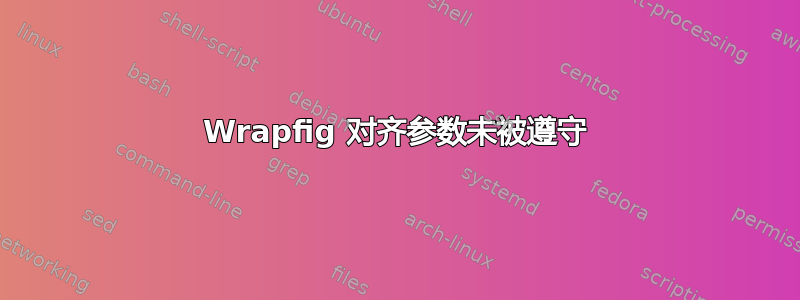
因此,我一直在编写操作指南,并且大多数图像似乎都与各个\wrapfigure{}部分正确对齐,直到我到达这一部分:
\documentclass{article}
\usepackage{graphicx}
\usepackage{wrapfig}
\title{Using Wordpress}
\author{Faris Chebib}
\begin{document}
\maketitle
…
\subsection*{Adding Media Content to Your Post}
Multimedia refers to images, audio, or videos and can be added to any of your
posts. Simply select the type of media you wish to add by selecting the
appropriate icon immediately above the content-entry box (below the title
input field; see fig~\ref{fig:post_media1}).
\begin{wrapfigure}{r}{0.5\textwidth}
\centering
\includegraphics[width=0.48\textwidth]{media_add1.png}
\caption{Adding an image (or other multimedia) begins by selecting the
image upload/insert icon.}
\label{fig:post_media1}
\end{wrapfigure}
Once the image upload icon is selected, a media menu will appear (see
fig~\ref{fig:post_media2}). This menu allows you to either upload a new image
(see fig~\ref{fig:select_image_fb})
or use a previously uploaded image in your post. Other kinds of multimedia
(such as audio and video) are also available in this menu. To use a
previously uploaded image, click on the \textit{Media Library} tab and select
your image (see fig~\ref{fig:media_library}).
\begin{wrapfigure}{l}{0.5\textwidth}
\centering
\includegraphics[width=0.48\textwidth]{media_add2.png}
\caption{To upload new media, select the \textit{select files}
option, then upload the file from your computer (see
fig~\ref{fig:select_image_fb}).}
\label{fig:post_media2}
\end{wrapfigure}
When your image has been selected and has successfully uploaded, you will
need to make some last adjustments with respect to how the image (or other
media) is ``layed into'' the post. Once you make these selections, remember
to click on the \textit{Insert into Post} button (see
fig~\ref{fig:insert_image}).
% THIS FIGURE SHOULD ALIGN RIGHT, BUT STAYS LEFT (Same for all {r} following)
\begin{wrapfigure}{r}{0.5\textwidth}
\centering
\includegraphics[width=0.48\textwidth]{select_image_fb.png}
\caption{Selecting an image from your local filesystem.}
\label{fig:select_image_fb}
\end{wrapfigure}
Once the image is inserted into the page (see
fig~\ref{fig:successful_insert}) you can continue editing the post as usual.
To adjust any image properties, or to remove the image, simply click on the
image and click on the appropriate button appearing on the image (the left
button accesses image editing functions while the right button deletes the
media).
\begin{wrapfigure}{l}{0.5\textwidth}
\centering
\includegraphics[width=0.48\textwidth]{media_library.png}
\caption{To select from previously uploaded images, click on the
\textit{Media Library Tab} and select the image you want to use.}
\label{fig:media_library}
\end{wrapfigure}
To add more multimedia, simply click on the appropriate media icon again and
continue to upload or add as before.
\begin{wrapfigure}{r}{0.5\textwidth}
\centering
\includegraphics[width=0.48\textwidth]{insert_image.png}
\caption{After uploading the media, you will need to make some final
adjustments to the style of the media as it is presented onto the post.}
\label{fig:insert_image}
\end{wrapfigure}
\subsection*{Formatting Text and Adding Hyperlinks}
\textit{Hyperlinks} or \textit{Links} refers to the interactive text on a web
page. This is the text that one can click on in order to open another web
site. To add a link, simply highlight the text you would like to turn into a
link and click on the add link button (just bellow the upload buttons). Once
selected, be sure to add the full \textit{URL} (Uniform resource locater;
\textit{eg:} \texttt{http://example.com}). This will turn the selected text
into a link to the \textit{URL} you specified.
\begin{wrapfigure}{l}{0.5\textwidth}
\centering
\includegraphics[width=0.48\textwidth]{successful_insert.png}
\caption{A successfully inserted image in a Blog Post.}
\label{fig:successful_insert}
\end{wrapfigure}
To format your text, simply select the text you would like to format by
clicking on the text and dragging the cursor until the selection matches the
text you would like to select. Once that text is selected, click on the font
format you would like to apply (on the top of the content box). For example,
you may click the \textbf{B} icon in order to make the font bold,
\textbf{like this} or you may select the \textit{I} icon in order to make
italicized text, \textit{like this}.
\subsection*{Publishing}
Finally, the publish box on the upper-right of the entry allows you to set
the date when the entry will be published. Alternately, if the entry is not
ready for public viewing, you may set the status to \textit{draft} and change
the visibility. You may also use the \textit{preview} button to produce a
sample preview of the page you are about to publish. It is always good
practice to create a preview of the entry before publishing a public version.
\section*{Adding a Static Page}
When you want to add content which isn't time-sensitive, such as an
\textit{About} page or a location information page, you will want to add a
\textit{Page}. To add a page, log into the wordpress administration panel and
select \textit{Pages}$>$\textit{Add New}. Once selected, you will be
presented with the add page view of the admin interface
(fig~\ref{fig:add_page}).
\begin{wrapfigure}{r}{0.5\textwidth}
\centering
\includegraphics[width=0.48\textwidth]{AddNewPageScreen.png}
\caption{The static post entry page. This page allows users to add a static
page which never expires.}
\label{fig:add_page}
\end{wrapfigure}
When adding a static, you may also want to add some multimedia. The method of
adding media is the exact same as the method described above. Remember, the
only difference between adding a Blog Post and a Static Page is that the
static page is \textit{not} time-sensitive.
\section*{Adding Events}
Events are similar to blog posts, but in addition to being time-sensitive,
also include a location entry stating where the event will take place. It is
important to list the location when adding an event, even if the location is
a virtual space (such as an Internet chatroom or webpage). To add an event,
click on the \textit{Add Event} link on the left-column
(fig~\ref{fig:add_event}).
\end{document}
所有后续图形的输出都向左对齐,而不是我想要的左、右、左…顺序。任何提示都将不胜感激。


